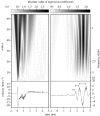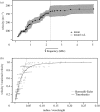Dispersive and non-dispersive waves through plants: implications for arthropod vibratory communication
- PMID: 17284408
- PMCID: PMC2124477
- DOI: 10.1098/rspb.2006.0306
Dispersive and non-dispersive waves through plants: implications for arthropod vibratory communication
Abstract
Vibratory communication in arthropods is a widespread phenomenon. Arthropods living on plants have been reported to use only dispersive bending waves in the context of prey-predator, competition, social and sexual interactions. Differences in signal structure have also been postulated to work as species recognition mechanisms and speciation agents. Using two identical laser Doppler vibrometers and a wavelet analysis, we quantified the wave propagation modes in rush stems (Juncus effusus) over the whole range of frequencies used by arthropods. A non-dimensionalized analysis shows that mechanical waves propagate not only as dispersive bending waves, but also as non-dispersive waves. Our analysis implies that an arthropod can communicate through non-dispersive bending waves by either producing signals of high frequencies or by choosing large stems, two widely different options tapping into the physiological and the behavioural repertoires, respectively. Non-dispersive waves, unreported so far in insect vibratory communication in plants, present serious advantages over dispersive bending waves in terms of signal integrity and may well be much more widely used than anticipated, in particular for species recognition.
Figures


Similar articles
-
A bending wave simulator for investigating directional vibration sensing in insects.J Acoust Soc Am. 2001 Jul;110(1):579-87. doi: 10.1121/1.1369106. J Acoust Soc Am. 2001. PMID: 11508982
-
Stink bug interaction with host plants during communication.J Insect Physiol. 2008 Jul;54(7):1113-24. doi: 10.1016/j.jinsphys.2008.06.004. Epub 2008 Jun 26. J Insect Physiol. 2008. PMID: 18634798 Review.
-
Interference of Overlapping Insect Vibratory Communication Signals: An Eushistus heros Model.PLoS One. 2015 Jun 22;10(6):e0130775. doi: 10.1371/journal.pone.0130775. eCollection 2015. PLoS One. 2015. PMID: 26098637 Free PMC article.
-
Directionality in the mechanical response to substrate vibration in a treehopper (Hemiptera: Membracidae: Umbonia crassicornis).J Comp Physiol A. 2000 Jul-Aug;186(7-8):695-705. doi: 10.1007/s003590000123. J Comp Physiol A. 2000. PMID: 11016785
-
Communication with substrate-borne signals in small plant-dwelling insects.Annu Rev Entomol. 2003;48:29-50. doi: 10.1146/annurev.ento.48.091801.112605. Epub 2002 Jun 4. Annu Rev Entomol. 2003. PMID: 12414736 Review.
Cited by
-
Collective defense of Aphis nerii and Uroleucon hypochoeridis (Homoptera, Aphididae) against natural enemies.PLoS One. 2010 Apr 29;5(4):e10417. doi: 10.1371/journal.pone.0010417. PLoS One. 2010. PMID: 20454683 Free PMC article.
-
Key physical wood properties in termite foraging decisions.J R Soc Interface. 2018 Dec 21;15(149):20180505. doi: 10.1098/rsif.2018.0505. J R Soc Interface. 2018. PMID: 30958236 Free PMC article.
-
Buzzing boundaries: tiny caterpillars vibrate to defend leaf tip territories.J Exp Biol. 2025 Apr 1;228(7):jeb249796. doi: 10.1242/jeb.249796. Epub 2025 Apr 1. J Exp Biol. 2025. PMID: 39927736 Free PMC article.
-
Resonance in herbaceous plant stems as a factor in vibrational communication of pentatomid bugs (Heteroptera: Pentatomidae).J R Soc Interface. 2012 Aug 7;9(73):1898-907. doi: 10.1098/rsif.2011.0770. Epub 2012 Feb 1. J R Soc Interface. 2012. PMID: 22298817 Free PMC article.
-
Variation in plant leaf traits affects transmission and detectability of herbivore vibrational cues.Ecol Evol. 2020 Sep 30;10(21):12277-12289. doi: 10.1002/ece3.6857. eCollection 2020 Nov. Ecol Evol. 2020. PMID: 33209287 Free PMC article.
References
-
- Barth F.G. Springer; Heidelberg, Germany; New York, NY: 2002. A spider's world: senses and behavior.
-
- Bell P.D. Transmission of vibrations along plant stems: implications for insect communication. N. Y. Entomol. Soc. 1980;88:210–216.
-
- Bennet-Clark H.C. Size and scale effects as constraints in insect sound communication. Phil. Trans. R. Soc. B. 1998;353:407–419. doi:10.1098/rstb.1998.0219 - DOI
-
- Casas J, Magal C. Mutual eavesdropping through vibrations in a host–parasitoid interaction: from plant biomechanics to behavioural ecology. In: Drosopoulos S, Claridge M.F, editors. Insect sounds and communication: physiology, behaviour, ecology and evolution. CRC Press; Boca Raton, FL: 2006. pp. 263–271.
-
- Casas J, Bacher S, Tautz J, Meyhöfer R, Pierre D. Leaf vibrations and air movements in a leafminer–parasitoid system. Biol. Control. 1998;11:147–153. doi:10.1006/bcon.1997.0593 - DOI
MeSH terms
LinkOut - more resources
Full Text Sources

